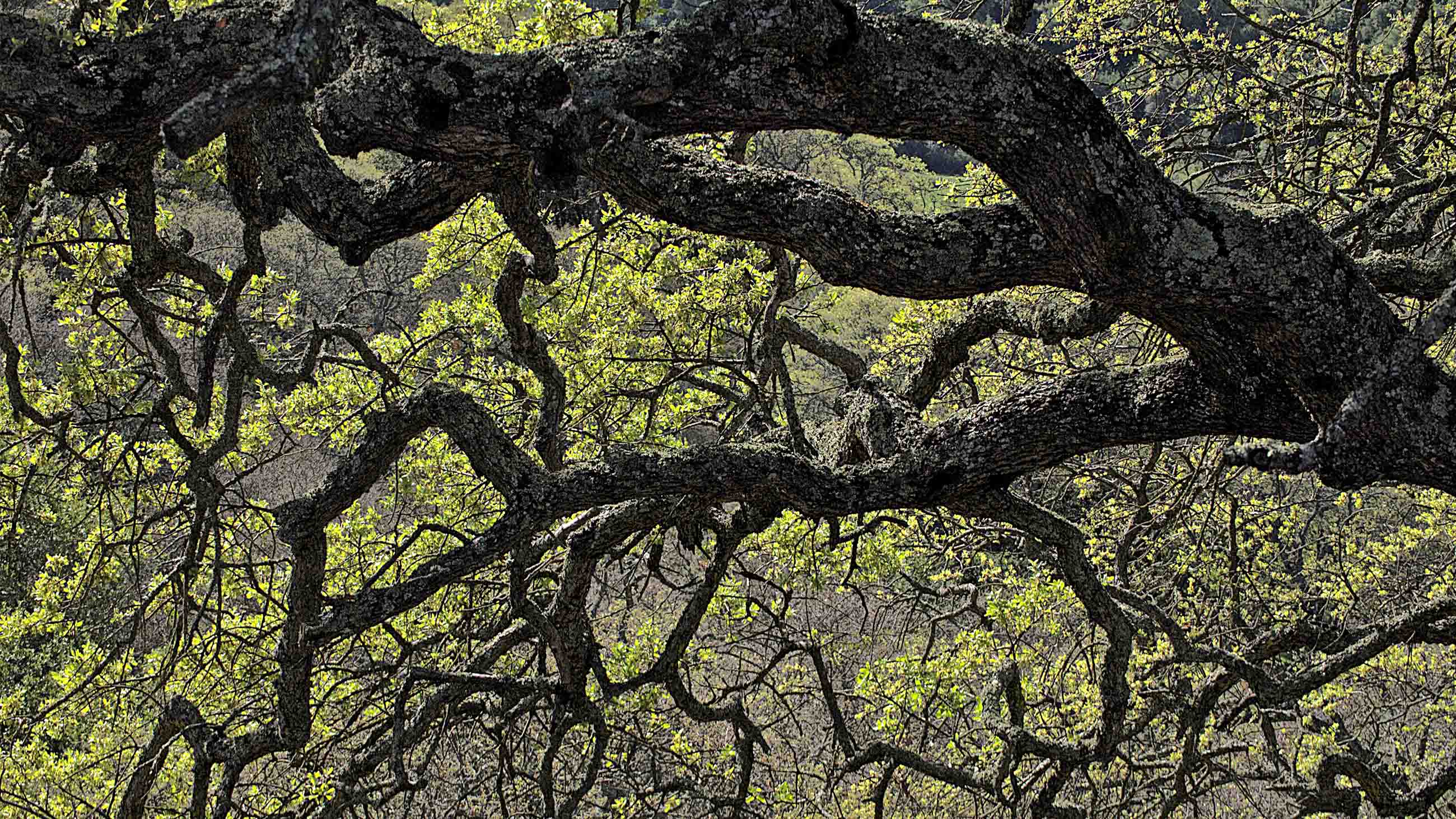Climate Extremes Are Putting Species in Sync — And in Danger
Every few winters, a high-pressure climate system called the North Pacific High flares up on California’s coast. For several months, northerly winds blow harder than usual down the continent’s West Coast, pushing coastal waters out to sea. The sea level drops, and a soup of nutrient-rich waters rises toward the surface from the depths. Thanks to this coastal upwelling, when the system is strong, everything from phytoplankton to seabirds thrives.
But the same climate feature pushes rain northward, parching the Interior West. In winters when the coast feasts, the Interior West’s land- and river-based systems starve. Alternatively, in winters when the North Pacific High is weak, the coast dries out, while the Interior West flourishes under heavy precipitation. Many Western ecosystems — from coastal ecosystems to landlocked forests and snow-dependent rivers — are in sync with the oscillating nature of the North Pacific High. That means that, even if they are nowhere near each other, scattered populations of the same species of trees will all seed at the same time, or butterflies of the same species will find food and flourish, using cues from this erratic climate phenomenon.
Now, by studying growth rings in the ear stones of long-lived fish and the trunks of ancient trees, researchers have found that the North Pacific High may be becoming more variable and driving a bigger swath of Western ecosystems to biological synchrony — a deceptively nice-sounding situation wherein disparate populations operate on the same clock despite being separated by distance. Unfortunately, synchrony could harm the West’s biodiversity, because it eliminates the natural variation that makes species resilient. And it is only expected to increase with continued human-caused climate change.
The study’s lead author, University of Texas marine biologist Bryan A. Black, began his research career as a forest ecologist. As he was finishing his graduate studies in tree-ring research, Black came across an advertisement for a postdoctoral position at the Hatfield Marine Science Center in Oregon, where he could study the growth rings that form in the ear stones, or otoliths, of fish that can live for more than a century. “I thought, well, maybe it’s possible that these techniques that had been so well developed by tree-ring scientists could be applied to growth increments of long-lived fish,” he said.
Otolith organs, which evolved long ago in vertebrates, aid balance and motion, and, in bony fish, assist hearing. Fish otoliths grow from calcium carbonate, the same material that forms shells, with layers of material accumulating each day. The growth of a fish’s otoliths depends on how much food that fish is getting. Otoliths, like trees, develop growth rings over time, so biologists can count them to learn a fish’s age as well as to measure its food intake.
Black examined the oval, pea-sized otoliths of splitnose rockfish, a species that can live longer than 80 years. Once full-grown, the spiny, solitary creatures — which have the approximate size and energy level of cinderblocks — dwell on the floor of the continental shelf from the Gulf of Alaska to Baja California, resting either near sheltering rocks or in shallow depressions that they excavate in soft sediments, feeding on shrimp and krill and sporting dour expressions that inspired one aquarium to call them the “grumpy cats of the deep blue sea.” All the while, their ear stones grow rings that record years of upwelling and years of hunger.
Black found that rockfish growth rings correlate with the variability in the winter North Pacific High: Rockfish grow more when the pressure system is strong, because it means better food supplies. And this is true of rockfish throughout the region, even if they live in separate populations. Other coastal animals show similar patterns. Seabirds, for example, rear more young successfully in strong North Pacific High winters, and the small marine invertebrates called copepods explode in population, providing an important food source for other ocean dwellers. “The winter can really be boom or bust in the marine system,” Black said, so more nutrients brought up by coastal upwelling have a sweeping effect on the ecosystem. The North Pacific High’s extremes create similarly intense environmental conditions throughout the California Current System, triggering similar responses from the region’s organisms. That pushes species to biological synchrony.
For the West’s wild organisms, scientists predict, that’s a gamble akin to investing all your money in a single stock.
Ecological stability requires having a “diverse portfolio of responses or behaviors,” Black said. The idea is that if one population gets wiped out by a local event — if a wildflower goes locally extinct because of drought, for example — nearby populations might be able to recolonize the community, perhaps by sprouting at a lusher time in future. But with increasing synchrony, “there’s less and less of a diverse portfolio that helps spread the risk,” Black said. “Everyone is tied to the same fate.”
And the synchrony created by the North Pacific High doesn’t end at the water’s edge. Dan Griffin, a tree-ring researcher at the University of Minnesota, examined growth patterns of old-growth blue oak trees in California and concluded that the West’s landlocked life is growing more synchronized, too. Blue oaks, which Griffin calls “Halloween trees” because of their gnarled, twisted shapes, are long-lived and deciduous, growing in open, parklike savannas between the forest and grasslands. Their growth is closely tied to water availability, so their tree rings are excellent record-keepers of drought. By coring old-growth blue oaks, Griffin could follow drought patterns in California going back hundreds of years. “You can look at a plant and just tell it has weathered centuries,” said Griffin, with trees whittled down to a few heavy craggy limbs, or missing their crowns because of windstorms or lightning. “Sometimes we’ll even see the root collar from centuries of erosion.” His team sampled living trees as much as three centuries old growing in 16 sites, and found that in years when rockfish feasted and their otoliths grew wide rings, the trees’ trunk rings grew only narrowly as the oaks suffered through drought. The tree rings extended the timeline for what Black has found with fish ear stones: Winter rains have become increasingly variable over the past 100 years, with drier dry years and wetter wet years. The result was that blue oaks’ growth became increasingly synchronized, with tree-ring patterns across the state more closely resembling each other over time.
The North Pacific High is also influencing the Interior West’s aquatic systems. Black looked at river discharge records from the West’s least disturbed watersheds from 1920 on. He found that in unusually strong North Pacific High years, rivers ran low across the region, while in unusually weak years, they ran high. “As (the North Pacific High) varies over time, it’s imprinting patterns in the marine, terrestrial and freshwater systems,” Black said. While the study did not look for a connection between increasing wobbliness in the North Pacific High’s extremes and climate change, more climate variability overall is predicted by climate change models.
Connie Woodhouse, a geographer and tree-ring researcher at the University of Arizona who was not part of the study, said a connection between the North Pacific High and increasing synchrony across the Interior West added up. “The fact that they’re finding that (the North Pacific High) is connected to stream flow, tree growth and precipitation in Western North America makes sense,” she said.
It’s not yet clear what the researchers’ findings mean for biodiversity. But other studies have confirmed that increasing variability and synchrony may be devastating, because species need population diversity to survive a constantly changing landscape. One study from 2002 found a connection between rising variability in winter rains and the extinction of two populations of the bay checkerspot, a protected butterfly. Researchers linked the insects’ disappearance to the increasingly variable October-through-April winter rainy season, which affected the growth of the local vegetation that the butterflies needed. Over the seven decades leading to their extinction, extremely wet and extremely dry years became more frequent, and the difference in rainfall from year to year grew. The seasonal appearance of the plants that the butterflies ate as larvae, including purple owl’s clover and dwarf plantain, became synchronous, following the rain’s fluctuations. Eventually, this meant that very hungry caterpillars showed up when food was not available.
Woodhouse cautioned that more research is needed before researchers know whether the same fate awaits other Western species. Most of the increased variability that Black and Griffin documented in the North Pacific High occurred over the last 50 years, which is not a very long time in the life of an old-growth tree. More information is needed to understand what increasing climate variance means for the West’s biodiversity. To that end, Black hopes to head to the Gulf of Alaska next, coring old-growth conifers and measuring growth patterns of centenarian bivalves called geoducks, searching for similar patterns connecting climate variability to synchrony — and possibly, to species survival — in another part of the West.
Maya L. Kapoor is an associate editor for High Country News.
This article was originally published on High Country News. It was republished as part of Climate Desk, a journalistic collaboration dedicated to exploring the impact — human, environmental, economic, and political — of a changing climate.










